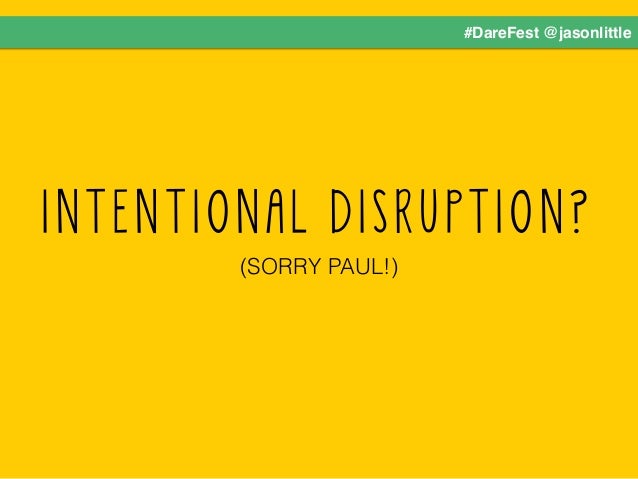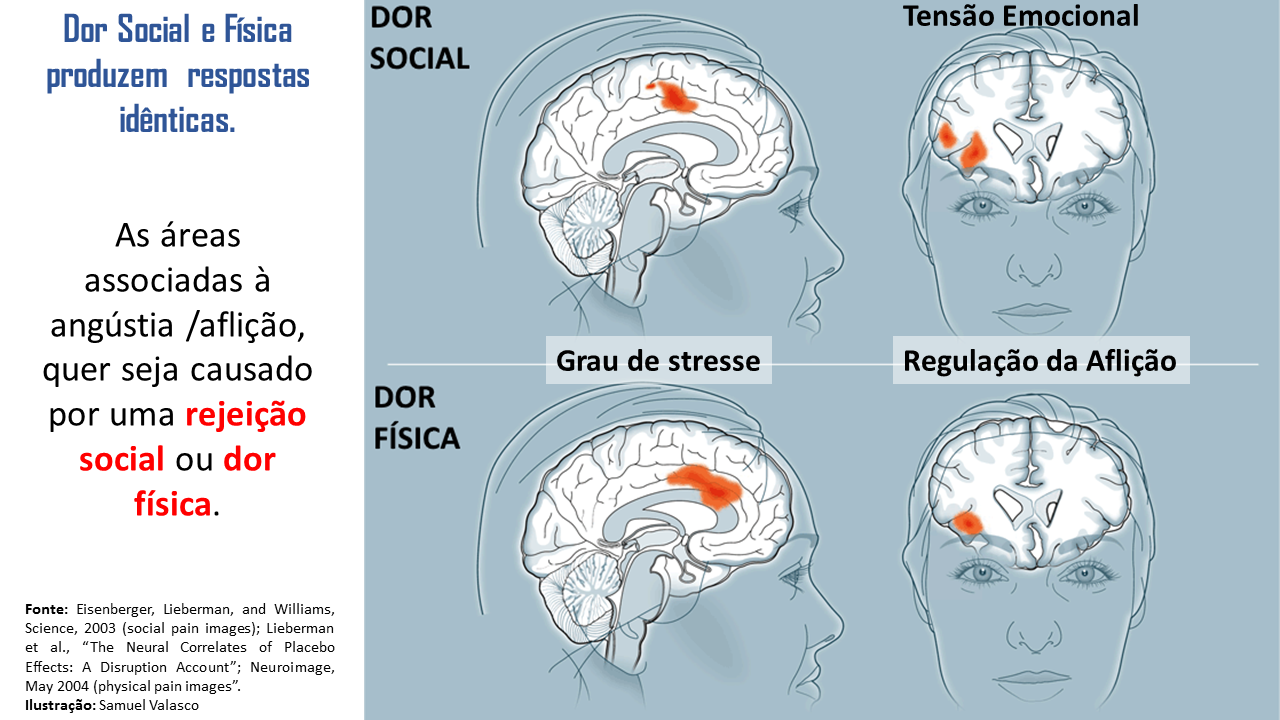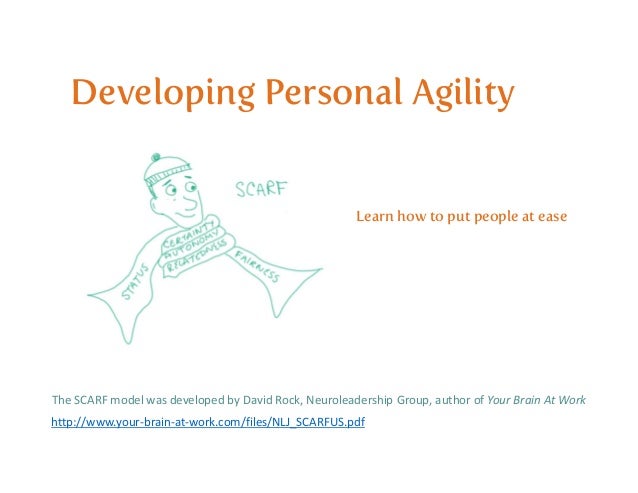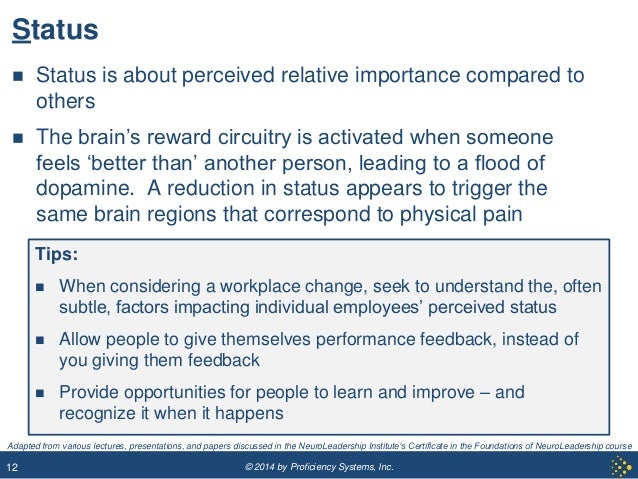David rock scarf model pdf
Rock’s SCARF model is a great example of his ability to translate the science into language appropriate for a lay business audience, and I expect to refer to it regularly in my work with coaching clients and MBA students. Many thanks, David.
David rock Ceo, Results Coaching systems international, GPo Box 395, sydney, NsW Australia 2001 Faculty, CiMBA Co-founder, NeuroLeadership institute editor, NeuroLeadership Journal davidrock@workplacecoaching.com In a world of increasing interconnectedness and rapid change, there is a growing need to improve the way people work together. understanding the true drivers of human …
SCARF – A MODEL FOR COLLABORATING WITH AND INFLUENCING OTHERS Fairness Transparency and clear expectations / Reward from fairness Unfairexchanges
SCARF Model In the second half of the book, Rock dives into five key attributes the brain cares deeply about: status, certainty, autonomy, relatedness, and fairness, or SCARF for
20/06/2013 · Hi David, Many thanks for taking the time to comment at such length and with such clarity. The aims you set out (“to build a more biologically-accurate language for how managers and leaders make decisions, manage their emotions, collaborate with …
10/7/2014 3:04 PM 1 S.C.A.R.F. Model S –Status C –Certainty A –Autonomy R –Relatedness F –Fairness Toward Threat Reward Away Permanent Long-term
Free PDF Download Books by David Rock. Neuroleadership is a new field of study drawing on the latest brain research to improve the quality of leadership and leadership development. The field is based
A neuroscience-based framework called the SCARF model, codified by David Rock, posits that five organizational factors have an immense, but often unnoticed, effect on negative human reactions.
In the SCARF Model David summarizes that to better influence and engage others, you can maximize their reward state while being sure not to threaten their Status, Certainty, Autonomy, Relatedness, or …
SCARF model David Rock What social situations trigger a threat response? How can we minimize the risk of social threat? How can we create safety? Read
Executive coach David Rock conducted an extensive study of the relevant research and developed the SCARF model [PDF] to help identify interpersonal dynamics that are likely to trigger a social
SCARF A model for creating environments for change Dr. David Rock. SCARF A model for creating environments for change Dr. David Rock . Visit. Discover ideas about Management Styles. SCARF – “Applying insights from social cognitive neuroscience to enhance leadership effectiveness”. Provides a free self-assessment “designed to transform the quality of thinking and performance. Management …
The SCARF Experience Train the Trainer Login

*David Rock-Neuro Leadership Institute
Dr. David Rock also developed a model called SCARF, which I encountered and find extremely useful as a tool when coaching. SCARF – Introduction Social needs are treated in much the same way in the brain as the need for food and water.
The SCARF model, developed by David Rock, provides a useful framework for understanding and influencing our interactions with others (including collaborations). It begins by identifying the overarching, organizing principle of the brain as: minimize danger and maximize reward.
The SCARF model is a well researched paradigm within neuroscience to help teachers support their students to be more intrinsically motivated. As teachers increase the students’ feelings of S. C. A. R. and F., they will feel better about themselves all around.
Don’t let preventable stress interfere with your next organization change. Learn from David Rock’s SCARF Model to anticipate and minimize perceived threats.
David Rock (2008) developed a brain-based model for thinking about how we collaborate with others; something inherently tied to matters of work and performance review. Based on five of our innate needs related to collaboration, Rock developed the acronym SCARF: Status, Certainty, Autonomy, Relatedness, and Fairness. When you think about the typical feedback session through the SCARF …
4 In this interview, David gives insights into understanding the brain, effectively developing leaders, and his innovative SCARF 360 model for assessments.

Read Neuroscience-of-engagement.pdf text version. Neuroscience of engagement. Dr. David Rock, Dr. Yiyuan Tang and Phil Dixon. This article was published in the. NeuroLeadershipjouRnal . issue TWO 2009. The attached copy is furnished to the author for non-commercial research and education use, including for instruction at the author’s institution, sharing with colleagues and providing to
24/03/2013 · This interview with David Rock, director of the NeuroLeadership Institute, was conducted and edited by Adam Bryant. Q. You’ve developed an acronym — SCARF — to better explain people’s
Joan Evans Executive Vice President, Innovation and Transformation Cone Health . One of the region’s largest, most comprehensive health networks Our Purpose & Intent: Together we create unsurpassed health care experiences & are the leader in delivering integrated, innovative health care 6 hospitals 100+ locations 12,000 employees 1,300 physicians 1,200 volunteers >B in revenue .9B in
www.neuroleadership.org NeuroLeadership JOURNAL VOLUME FIVE AUGUST 2014 The Science of Making Learning Stick: AnU pdatet ot he AGES Model Josh Davis, Maite Balda, David Rock, Paul McGinniss and Lila Davachi
1 SCARF: a brain-based model for collaborating with and influencing others David rock Ceo, Results Coaching Systems international, GPo Box 395, Sydney, NSW Australia 2001 – David Rock, “Managing With the Brain in Mind”
SCARF: model založený na na znalostech o mozku sloužící ke spolupráci a ovlivňování ostatních od Davida Rocka Tento článek vyšel v prvním vydání časopsisu NeuroLeadership JOURNAL.
View Notes – SCARF-NeuroleadershipArticle.pdf from BSCI 651 at Pepperdine University. SCARF: a brain-based model for collaborating with and influencing others David Rock This article was published in

Review the model of all 15 EI competencies. “Five Big Discoveries About Personal Effectiveness,” David Rock, Psychology Today. Understanding the threat response, subconscious drivers of behaviour and executive functioning: SCARF (Status, Certainty, Autonomy, Relatedness, Fairness) model, by David Rock.
The sCARF model (Rock, 2008) was introduced as an important model to help managers understand the five domains of social experience that the brain is always
SCARF Model for Social Triggers This is an overview of SCARF Model, an easy way to remember and act upon the social triggers that can generate both the approach and avoid responses.
The Neuroscience of Change and the SCARF ® Model The SCARF® model is a summary of five domains of human social experience, which are factors that can activate a reward or threat response in social situations. It is an easy way to remember social triggers that activate either the approach or avoid responses – this is critical for successful change. The SCARF® model points to ways to
How to Influence People Using the SCARF Model
David Rock has been giving permission to people to use SCARF in books and commercial training programs where it makes sense to. Once again – it is the commercial usage of the model …
The SCARF model of behavior is a relatively new theory, having first been published in 2008 by David Rock. The word SCARF is an acronym, which stands for: The word SCARF is …
Apply the “SCARF” model -Status, Certainty, Autonomy, Relatedness, and Fairness – in performance conversations. Make sure each part of your performance review process is focused improvement rather than simple evaluation.
SCARF Model In the second half of the book, Rock dives into five key attributes the brain cares deeply about: status, certainty, autonomy, relatedness, and fairness, or SCARF for short. Our brain treats these attributes almost as intensely as survival instincts. – tear you apart sarah cross pdf I recently came across David Rock’s Psychology Today blog named your brain at work. He has recently published a book by the same name and though I haven’t read the book yet, I was sufficiently engrossed by his ideas to read up on his proposed SCARF model in the NueroLeadership journal (2008).
SCARF – “Applying insights from social cognitive neuroscience to enhance leadership effectiveness”. Provides a free self-assessment “designed to transform the quality of thinking and performance.
Potential Applications of Neuroscience to Management To better address this issue Rock (2008d) developed the SCARF model that attempts to summarize the two themes raised by Gordon, and Lieberman & Eisenberger. The SCARF model does so within a framework that captures the common factors that can activate a reward or threat response in social situations. This model can be applied …
David Rock – SCARF Model of Social Experience Changequest It is now known that the brain organises things using a basic threat or reward principle, and …
SCARF model : a brain based model for collaborating with and influencing others (David Rock) [PDF] Change Management Neuroscience – Limbic Zen (John Barbuto) [A] Engagement, emotions and change management – Limbic Zen (John Barbuto) [A]
Presents David Rock’s SCARF model that summarizes the top five social rewards and threats important to the brain and discusses how HR and talent management professionals can use this model to improve employee and organizational performance. M Neuroscience is the study of how the nervous system develops, its structure, and what it does. The field’s focus is on the workings of the brain, …
We recently came across a you-tube video by David Rock about his SCARF model. David outlines five environmental factors that the brain is monitoring, mostly at a level below conscious awareness, yet which have a tremendous impact on our level of motivation.
David Rock went on to develop the SCARF model which we will explore later in this paper. Hard edge with a pointy end With technology and other global forces demanding unprecedented agility to remain competitive, neuroscience offers organisations a clear value proposition. As long as humans continue to work in organisations, human performance and employee engagement will be integral to business
While having minimal knowledge of the SCARF model developed by Dr David Rock (which is the basis of the article), I had not thought enough about how relevant it is to our careers. The SCARF model offers us personal insights around our drivers to assist us in improving our ability to collaborate with and influence others in the workplace. The SCARF model involves five domains of human social
SCARF – a new model of human motivation October 14, 2011 Simon Leadership Development It is a testament to the work of Abraham Maslow that his model of human motivation has endured for the best part of 70 years.
A leading neuroscience practitioner and proponent, David Rock, coined the term NeuroLeadership. Drawing on global research he has developed the SCARF model to help us to understand fundamental drivers of human social behavior.
You can learn more about Dr. David Rock’s SCARF 360 by watching the video below. (1) Rock, D (2008). SCARF: a brain-based model for collaborating with and influencing others, NeuroLeadership Journal Issue One.
I decided to build on David’s work and use the SCARF as a framework for organizing tips and techniques for improving work interactions and ultimately increasing engagement and performance. The SCARF model includes five domains: Status, Certainty, Autonomy, Relatedness and Fairness.
the tried & true series: trusted models that stand the test of time anticipating organization stress the scarf model threat to status threat to certainty threat to …
SCARF model” Relatedness – Turning enemies into friends When you connect with people you like or can trust you get a decrease in the stress hormone ‘cortisol’ and an injection of the ‘feel good’ hormone dopamine. In other words, you experience more ‘toward’ emotions.
The SCARF model, which David calls the most important work he’s done And why high (but not too high) stress situations can actually bring out your best work. You can follow David Rock on Twitter at @DavidRock101 and on his blog, David Rock .
David Rock’s SCARF Model for Change Agile Uprising
SCARF: model založený na na znalostech o mozku sloužící ke spolupráci a ovlivňování ostatních (od David Rock) Tento článek vyšel v prvním vydání časopsisu NeuroLeadership JOURNAL.
Turn the 360 around – Phil Dixon, Dr. David Rock and Dr. Kevin Ochsner One Simple Idea That Can Transform Performance Management – Dr. David Rock, Dr. Josh Davis, and Elizabeth Jones Defining NeuroLeadership as a field – David Rock and Dr. Al H. Ringleb
About SCARF Train-the-Trainer™ Workshop Designed for companies seeking cost effective ways to imbed SCARF® into your organization, the SCARF Train-the-Trainer ™ provides licensing for delivery of The SCARF Experience™ internally. Our format provides companies with the autonomy to appoint trainers, internal or external, to be certified for delivery. Once appointed, trainers attend our
Joyful Learning and David Rock’s SCARF Model Willis’s perspective on “joyful learning” is embedded in David Rock’s SCARF Model , which provides a useful framework for understanding how our brains respond to social threats and rewards.
The SCARF model David Rock’s SCARF model (pdf download) summarises some of the key learnings from neuroscience in relation to human behaviour, and presents it in a easily digestible format. The model is based on a simple premise: that just like our ancient ancestors, we assess all new information with a view to either:
The five domains of human social experiencethe SCARF model

New Infographic SCARF Model Partnering Resources
Model SCARF – David Rock Profikoucink.eu

Understanding David Rock’s SCARF Model ISTE 2018
Five ways to understand the brain the SCARF model and


Emotional Self Awareness Show notes episode 3 The
SCARF – a new model of human motivation Brilliant Leader
what happened to goodbye sarah dessen pdf – SCARF model – David Rock Discovery in Action
SCARF model založený na na znalostech o mozku sloužící ke


S.C.A.R.F. Model Montclair State University
The SCARF Model David Rock – The Development Alchemists
How to Influence People Using the SCARF Model
Rock Cox SCARF in 2012 updating the social AHRI
David Rock (2008) developed a brain-based model for thinking about how we collaborate with others; something inherently tied to matters of work and performance review. Based on five of our innate needs related to collaboration, Rock developed the acronym SCARF: Status, Certainty, Autonomy, Relatedness, and Fairness. When you think about the typical feedback session through the SCARF …
Potential Applications of Neuroscience to Management To better address this issue Rock (2008d) developed the SCARF model that attempts to summarize the two themes raised by Gordon, and Lieberman & Eisenberger. The SCARF model does so within a framework that captures the common factors that can activate a reward or threat response in social situations. This model can be applied …
A leading neuroscience practitioner and proponent, David Rock, coined the term NeuroLeadership. Drawing on global research he has developed the SCARF model to help us to understand fundamental drivers of human social behavior.
Presents David Rock’s SCARF model that summarizes the top five social rewards and threats important to the brain and discusses how HR and talent management professionals can use this model to improve employee and organizational performance. M Neuroscience is the study of how the nervous system develops, its structure, and what it does. The field’s focus is on the workings of the brain, …
SCARF A model for creating environments for change Dr. David Rock. SCARF A model for creating environments for change Dr. David Rock . Visit. Discover ideas about Management Styles. SCARF – “Applying insights from social cognitive neuroscience to enhance leadership effectiveness”. Provides a free self-assessment “designed to transform the quality of thinking and performance. Management …
The SCARF model is a well researched paradigm within neuroscience to help teachers support their students to be more intrinsically motivated. As teachers increase the students’ feelings of S. C. A. R. and F., they will feel better about themselves all around.
I decided to build on David’s work and use the SCARF as a framework for organizing tips and techniques for improving work interactions and ultimately increasing engagement and performance. The SCARF model includes five domains: Status, Certainty, Autonomy, Relatedness and Fairness.
Joan Evans Executive Vice President, Innovation and Transformation Cone Health . One of the region’s largest, most comprehensive health networks Our Purpose & Intent: Together we create unsurpassed health care experiences & are the leader in delivering integrated, innovative health care 6 hospitals 100 locations 12,000 employees 1,300 physicians 1,200 volunteers >B in revenue .9B in
Make Getting Feedback Less Stressful Ideas and Advice
SCARF-NeuroleadershipArticle.pdf SCARF a brain-based
SCARF Model In the second half of the book, Rock dives into five key attributes the brain cares deeply about: status, certainty, autonomy, relatedness, and fairness, or SCARF for short. Our brain treats these attributes almost as intensely as survival instincts.
SCARF A model for creating environments for change Dr. David Rock. SCARF A model for creating environments for change Dr. David Rock . Visit. Discover ideas about Management Styles. SCARF – “Applying insights from social cognitive neuroscience to enhance leadership effectiveness”. Provides a free self-assessment “designed to transform the quality of thinking and performance. Management …
The Neuroscience of Change and the SCARF ® Model The SCARF® model is a summary of five domains of human social experience, which are factors that can activate a reward or threat response in social situations. It is an easy way to remember social triggers that activate either the approach or avoid responses – this is critical for successful change. The SCARF® model points to ways to
The sCARF model (Rock, 2008) was introduced as an important model to help managers understand the five domains of social experience that the brain is always
David Rock has been giving permission to people to use SCARF in books and commercial training programs where it makes sense to. Once again – it is the commercial usage of the model …
Review the model of all 15 EI competencies. “Five Big Discoveries About Personal Effectiveness,” David Rock, Psychology Today. Understanding the threat response, subconscious drivers of behaviour and executive functioning: SCARF (Status, Certainty, Autonomy, Relatedness, Fairness) model, by David Rock.
SCARF – A MODEL FOR COLLABORATING WITH AND INFLUENCING OTHERS Fairness Transparency and clear expectations / Reward from fairness Unfairexchanges
SCARF Model In the second half of the book, Rock dives into five key attributes the brain cares deeply about: status, certainty, autonomy, relatedness, and fairness, or SCARF for
Joan Evans Executive Vice President, Innovation and Transformation Cone Health . One of the region’s largest, most comprehensive health networks Our Purpose & Intent: Together we create unsurpassed health care experiences & are the leader in delivering integrated, innovative health care 6 hospitals 100 locations 12,000 employees 1,300 physicians 1,200 volunteers >B in revenue .9B in
The SCARF model, which David calls the most important work he’s done And why high (but not too high) stress situations can actually bring out your best work. You can follow David Rock on Twitter at @DavidRock101 and on his blog, David Rock .
Presents David Rock’s SCARF model that summarizes the top five social rewards and threats important to the brain and discusses how HR and talent management professionals can use this model to improve employee and organizational performance. M Neuroscience is the study of how the nervous system develops, its structure, and what it does. The field’s focus is on the workings of the brain, …
David Rock – SCARF Model of Social Experience Changequest It is now known that the brain organises things using a basic threat or reward principle, and …
24/03/2013 · This interview with David Rock, director of the NeuroLeadership Institute, was conducted and edited by Adam Bryant. Q. You’ve developed an acronym — SCARF — to better explain people’s
SCARF: model založený na na znalostech o mozku sloužící ke spolupráci a ovlivňování ostatních od Davida Rocka Tento článek vyšel v prvním vydání časopsisu NeuroLeadership JOURNAL.
Emotional Self Awareness Show notes episode 3 The
Re use of the term NEUROLEADERSHIP
A neuroscience-based framework called the SCARF model, codified by David Rock, posits that five organizational factors have an immense, but often unnoticed, effect on negative human reactions.
The Neuroscience of Change and the SCARF ® Model The SCARF® model is a summary of five domains of human social experience, which are factors that can activate a reward or threat response in social situations. It is an easy way to remember social triggers that activate either the approach or avoid responses – this is critical for successful change. The SCARF® model points to ways to
Apply the “SCARF” model -Status, Certainty, Autonomy, Relatedness, and Fairness – in performance conversations. Make sure each part of your performance review process is focused improvement rather than simple evaluation.
In the SCARF Model David summarizes that to better influence and engage others, you can maximize their reward state while being sure not to threaten their Status, Certainty, Autonomy, Relatedness, or …
David Rock went on to develop the SCARF model which we will explore later in this paper. Hard edge with a pointy end With technology and other global forces demanding unprecedented agility to remain competitive, neuroscience offers organisations a clear value proposition. As long as humans continue to work in organisations, human performance and employee engagement will be integral to business
SCARF model : a brain based model for collaborating with and influencing others (David Rock) [PDF] Change Management Neuroscience – Limbic Zen (John Barbuto) [A] Engagement, emotions and change management – Limbic Zen (John Barbuto) [A]
David Rock (2008) developed a brain-based model for thinking about how we collaborate with others; something inherently tied to matters of work and performance review. Based on five of our innate needs related to collaboration, Rock developed the acronym SCARF: Status, Certainty, Autonomy, Relatedness, and Fairness. When you think about the typical feedback session through the SCARF …
David Rock – SCARF Model of Social Experience Changequest It is now known that the brain organises things using a basic threat or reward principle, and …
SCARF – “Applying insights from social cognitive neuroscience to enhance leadership effectiveness”. Provides a free self-assessment “designed to transform the quality of thinking and performance.
Presents David Rock’s SCARF model that summarizes the top five social rewards and threats important to the brain and discusses how HR and talent management professionals can use this model to improve employee and organizational performance. M Neuroscience is the study of how the nervous system develops, its structure, and what it does. The field’s focus is on the workings of the brain, …
David Rock has been giving permission to people to use SCARF in books and commercial training programs where it makes sense to. Once again – it is the commercial usage of the model …
While having minimal knowledge of the SCARF model developed by Dr David Rock (which is the basis of the article), I had not thought enough about how relevant it is to our careers. The SCARF model offers us personal insights around our drivers to assist us in improving our ability to collaborate with and influence others in the workplace. The SCARF model involves five domains of human social
About SCARF Train-the-Trainer™ Workshop Designed for companies seeking cost effective ways to imbed SCARF® into your organization, the SCARF Train-the-Trainer ™ provides licensing for delivery of The SCARF Experience™ internally. Our format provides companies with the autonomy to appoint trainers, internal or external, to be certified for delivery. Once appointed, trainers attend our

SCARF model” Relatedness – Turning enemies into friends When you connect with people you like or can trust you get a decrease in the stress hormone ‘cortisol’ and an injection of the ‘feel good’ hormone dopamine. In other words, you experience more ‘toward’ emotions.
How to Influence People Using the SCARF Model
David Rock went on to develop the SCARF model which we will explore later in this paper. Hard edge with a pointy end With technology and other global forces demanding unprecedented agility to remain competitive, neuroscience offers organisations a clear value proposition. As long as humans continue to work in organisations, human performance and employee engagement will be integral to business
Managing People Workplace Change and Neuroscience